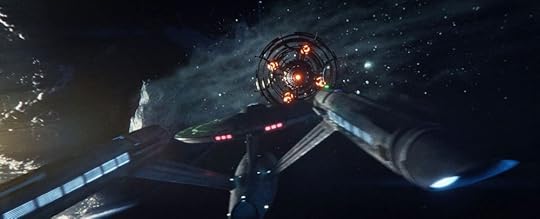Thoughts on Star Trek: Strange New Worlds
Star Trek peaked in the early nineties. Trek fans could feast on their pick of golden-age shows: Star Trek: The Next Generation. Star Trek: Deep Space Nine. Star Trek: Voyager. After a bit of a lull, Star Trek: Enterprise attempted to revitalize the franchise in the early two-thousands. Enterprise was perhaps the first flat-footed attempt in what would become a series of misfires to ride the Star Trek coat tails. I liked Enterprise, but it was off, in the way that watching fan fiction is often off. The problem is that the heart of Star Trek is not warp nacelles, phasers and transporters. If there’s one thing I wish I could convince the writers of 2022, it’s just that. It’s not about the gadgets. If you think back to the Next Generation, you’ll instantly envision Captain Picard giving a principle-based speech to either his crew or aliens at a critical decision. If you think of Voyager, you’ll see Janeway wrestling with doing the right thing while trying to get her crew home. In each case, the crews are good, professional people trying their best to help others. Star Trek, for all of its high tech gadgetry, is fundamentally about its characters and the trials they face in their quest to do good.
The J.J.Abrams reboots somewhat exasperated the flat-footed problem by falling into the sugar-rush hyper activeness of the CGI special effects trap, a trend that would continue to modern day. His plots often used hand-waves to ignore non-sensical elements, scooting the viewer along with the next glitzy explosion to keep him from thinking too much. The first movie was, admittedly, enjoyable, however, because it tapped into a bit of the goofy sense of adventure that permeated the original series. Sure, the characters were in life-and-death situations, but they were having fun, and their fun extended to the viewer.
In the past few years, Star Trek has returned with Star Trek: Discovery and Star Trek: Picard. I made it through about three episodes of each. These illustrate my point that gluing warp nacelles onto your ship is not enough to make it Star Trek. Fortunately, you can imagine that the executives at Paramount read the tea leaves and said, “You know, there’s probably a whole segment out there that we can market to that just wants plain old Star Trek.” And so, Star Trek: Strange New Worlds was born.
I’m two episodes into Strange New Worlds and I like it. It’s not perfect, and it is, indeed, plain old Star Trek (perhaps to a fault). The opening credits encapsulate the show nicely. It’s a mix of classic elements and glitzy CGI. It’s not a nineties Star Trek series, but it’s not a Star Trek: Discovery series either. It’s somewhere in between:
The original 1960s Star Trek pilot had the Enterprise commanded by Christopher Pike, with Spock as his science officer and Majel Barrett as Number One. Star Trek: Strange New Worlds returns to this Pike-captained Enterprise. Spock is here, and the show takes some liberties by introducing Uhura as a cadet. Pike, played by Anson Mount, is charismatic and kind. He’s instantly likable and seems like the type of captain you’d like to work for. He has some crazy graying hair (sometimes upstaging him) which Anson jokes about as being “the best hair in sci-fi”.
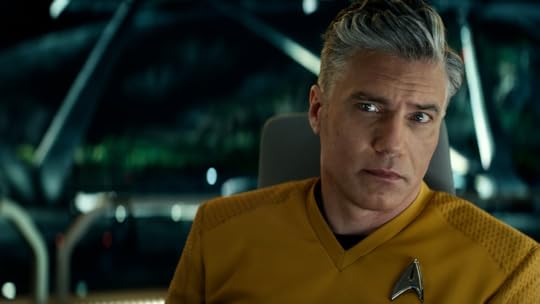
Rebecca Romijn plays Number One. She’s serious and professional, in much the same way that Majel Barrett was in the pilot.
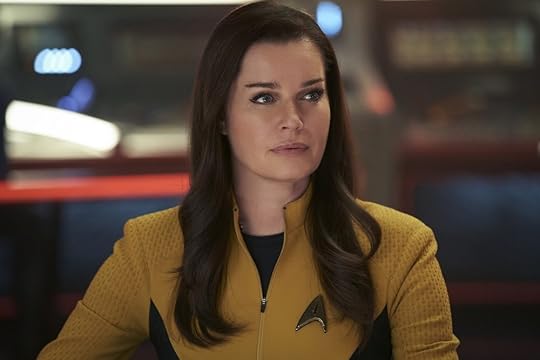
Spock is played by Ethan Peck. The writers have tried, once again for some reason, to coolify Spock. To all of the current and future Star Trek writers: please stop. Spock does not need to be made cooler. Strange New Worlds Spock is certainly likable, but the viewer being introduced to a shirtless Spock about to have a love scene, talking with Pike on a viewer while his scantily-clad partner reclines on the bed just seems very J.J. Abrams. Spock is not James Bond. Spock is Spock. That being said, the actor, like the entire cast, is excellent and brings a warmth to his character.
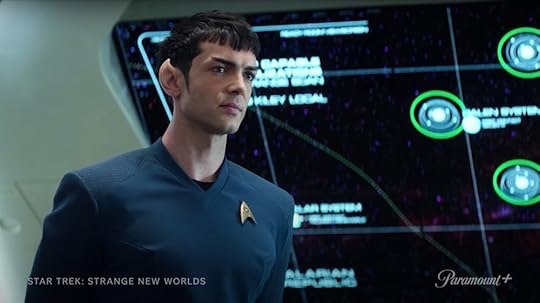
Other notable officers include:
Melissa Navia as Erica Ortegas. Warm and interesting, like the other characters, but I kept expecting her to speak Belter and to hail to Rocinante. Christian Chong as the security officer La’an Noonien Singh. Yes…same last name as Khan Noonien Singh. That Khan. I’m not sure where the writers are going with that, but I ask them: wherever it is, is it necessary? Can’t we just have a bridge crew that are their own interesting people without each person needing to have some monumental dark past? I mean, do you remember Scotty’s dark past? Chekov’s? No you don’t. Were they interesting and fun characters nonetheless? Yes they were. For the record, if we end up with a scene where Pike yells “La’an!” into a communicator, I will be quite disappointed.
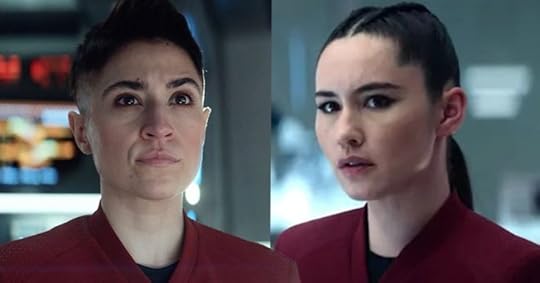
In sick bay we go a little off the rails with Nurse Chapel, played by Jess Bush. For some reason the writers have given Nurse Chapel a borderline personality disorder where she likes to surprise-inject people with painful hyposprays because it’s “more fun that way”. I imagine they were shooting for quirky but ended up with someone you’d probably get a restraining order against. By they way, none of these comments are critiques on the actors. I think they are all superb. It’s critiques on the writing.

Uhura appears as a cadet who is not sure she wants to be in Starfleet, played by Celia Rose Gooding. Although she doesn’t seem like the cool professional portrayed in 1960s Trek, she does a great job of fulfilling the role of a fresh-out-of-school talented cadet with a bright future. One could imagine how she would mature into the Uhura on Kirk’s Enterprise.
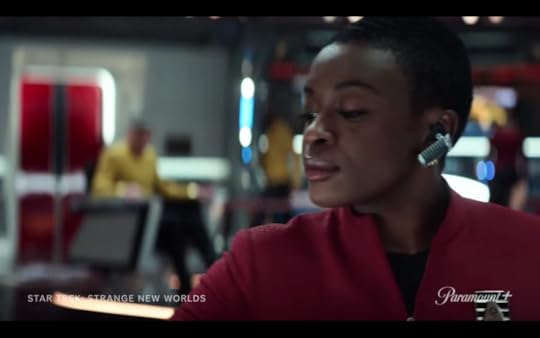
I had to think a bit about how to describe the sets, and the best description is that the series has its own look. I think, overall, I like it. There are elements of the original 1960s concepts extrapolated to the hyper-modern look of more recent Star Trek series. The result is something that’s neither over-the-top nor overly retro. It works.
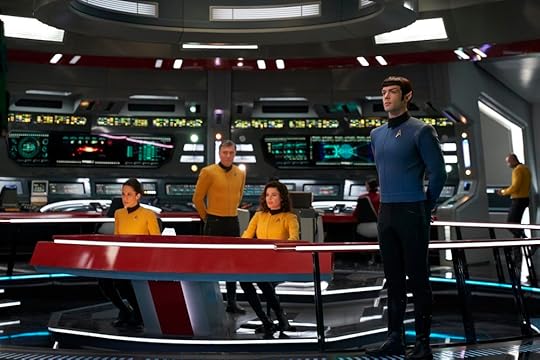

And now, the plots. I was pleasantly surprised to see straight-forward plots that even took breathers for character development. Case in point: Episode Two starts with Uhura nervously attending a dinner with the Captain and other officers. A good five minutes of nothing but dialogue exchanges occurs over dinner, and we learn something about both Uhura and Pike. A lesser series would get about one minute into the scene before there was an attempted mutiny or surprise attack, but Strange New Worlds lets the characters breathe. The dinner ends not with a “Shields Up! Red Alert!”, but with Spock walking Uhura back while chatting with her about her Starfleet uncertainty.
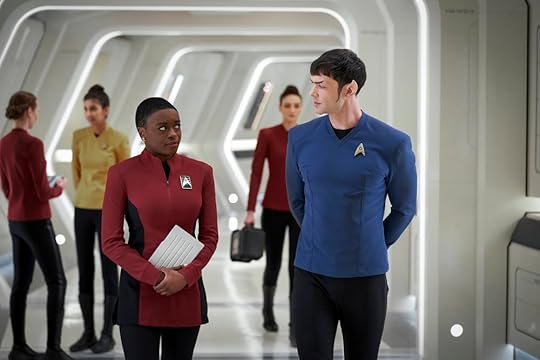
The first episode is a Prime Directive/First Contact plot where a pre-warp civilization (think Earth 21st century) has somehow created a warp signature. Contact was lost with the Starfleet ship sent there to investigate. When Pike and crew arrive, they must beam down to the plant disguised as locals to find the missing crew members and determine what’s happened. The resolution involves a classic captain’s soliloquy to the alien leaders. It feels like Star Trek. This could easily be a Captain Picard speech, and you feel like you’ve seen this setup before. In fact, it’s a basic plot from classic episodes that has one element spun (how they created the warp signature and what it will be used for).
Episode two has a comet on a collision course for a planet that houses a primitive civilization. When Enterprise attempts to nudge the comet away from the planet, they discover it is actually a technological device. If this plot sounds familiar, it is, essentially, a spin on the 1960s episode, “For the World is Hollow and I Have Touched the Sky”. In that episode, Enterprise is sent to divert an asteroid on a collision course with an inhabited planet. The asteroid is technological, and contains an entire world within it. The world’s inhabitants are oblivious to the fact that they live in an asteroid, and they are kept that way by a central computer. Similar to Strange New World’s episode one, episode two is a mash-up of classic episodes with one element flipped. Pike and the Enterprise crew resolve the situation not with force but by being clever, which, once again, is a good thing.
So, what to make of it? I like it. It feels like its own show, which actually says a lot considering it is using several pre-established characters and events. The environments are a bit magical, in the same way that the Lost in Space Netflix series does an excellent job of evoking a sense of adventure and wonder with its strange locations, and I hope there are many actual strange new worlds ahead of us in the series.
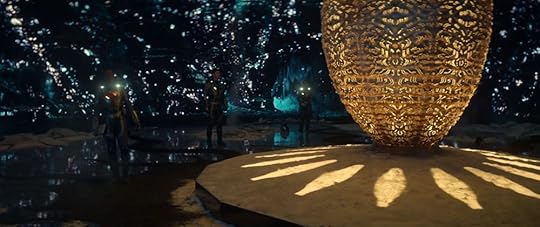
The crew is very likable and every now and then the shows pauses to let them be people - which is something that’s been lacking in so many recent Star Trek attempts - and they do have the classic Star Trek vibe of good people trying to do good things. The plots feel a little lazy so far, dusting off classic episodes and swapping out one thing for another to call it something new, but the execution of the episodes is done well and both have been enjoyable. I’m cautiously optimistic about where the journey is heading, and looking forward to the next episodes to find out.
